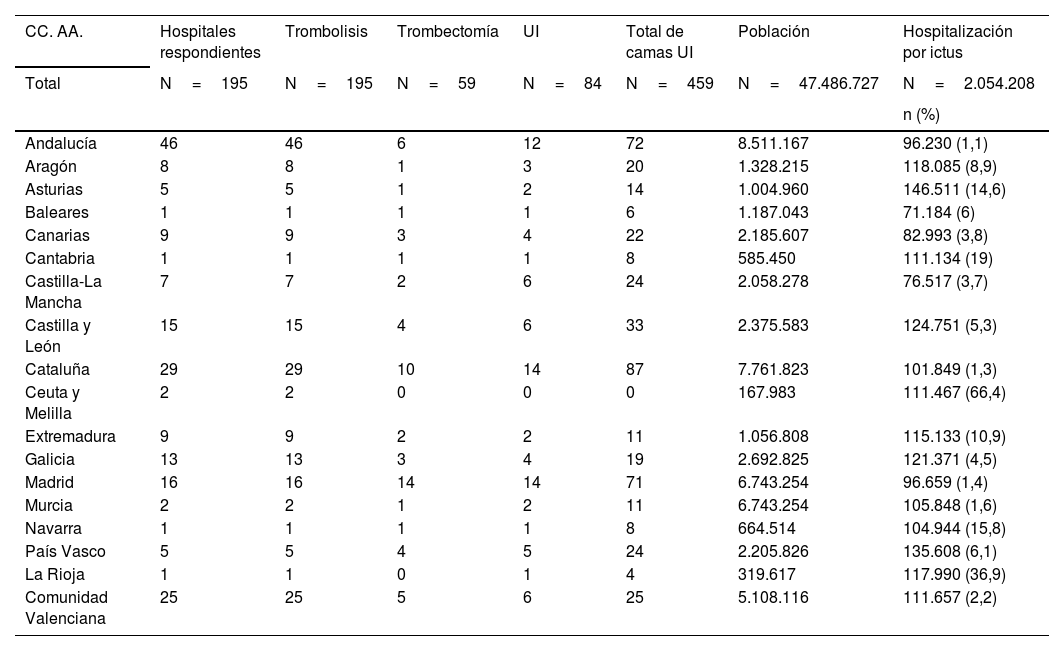Identificar y describir la distribución geográfica de hospitales en España que ofrecen atención especializada para el ictus, así como los recursos disponibles.
MétodoEstudio observacional descriptivo transversal. Se recogieron los datos de hospitales en España entre febrero y junio de 2023, mediante contacto telefónico y correos electrónicos a los departamentos de neurología. Los hospitales incluidos debían contar con una unidad de ictus (UI) y/o capacidad para realizar trombólisis o trombectomías. Se excluyeron aquellos sin capacidad para manejar el ictus en fase hiperaguda. Se recogieron los datos sobre la disponibilidad de UI, camas y capacidad para realizar tratamientos de recanalización.
ResultadosSe incluyeron 195 hospitales, de los cuales todos reportaron realizar trombólisis, pero solo el 30,2% ofrecía trombectomía. La disponibilidad de UI fue reportada por el 43% de los hospitales, con un total de 459 camas. Cataluña y Madrid lideraron en número de UI (14 cada una) y camas (87 y 71, respectivamente). En contraste, regiones como La Rioja, Baleares y Ceuta y Melilla presentaron capacidades limitadas. La variabilidad en la distribución de recursos fue significativa, con algunas comunidades sin acceso a trombectomía.
ConclusiónLos resultados revelan disparidades importantes en la disponibilidad de recursos para el tratamiento del ictus en España, con una marcada desigualdad geográfica que podría impactar negativamente en los resultados clínicos. Es necesaria una planificación de recursos más equitativa y estrategias de mejora como la telemedicina y las redes de derivación para reducir estas desigualdades y mejorar los resultados en salud a nivel nacional.
Identify and describe the geographic distribution of hospitals in Spain that offer specialized stroke care as well as available resources.
MethodsCross-sectional descriptive observational study. Data were collected from hospitals in Spain between February and June 2023 through telephone and email contact with neurology departments. Hospitals had to have a stroke unit (SU) and/or the capacity to perform thrombolysis or thrombectomy. Patients without the capacity to manage stroke in the hyperacute phase were excluded. Data on the availability of SUs and beds and the capacity to perform recanalization treatments were collected.
ResultsA total of 195 hospitals were included, all of which reported performing thrombolysis; however, only 30.2% offered thrombectomy. The availability of SUs was reported by 43% of the hospitals, with a total of 459 beds. Catalonia and Madrid had the highest number of SUs (14 each) and beds (87 and 71, respectively). In contrast, regions such as La Rioja, the Balearic Islands, and Ceuta and Melilla had limited capacities. Variability in the distribution of resources was significant, with some regions lacking access to thrombectomy.
ConclusionThe results revealed significant disparities in the availability of resources for stroke treatment in Spain, with marked geographic inequalities that could negatively impact clinical outcomes. More equitable resource planning and improvement strategies such as telemedicine and referral networks are necessary to reduce these disparities and improve health outcomes nationwide.
Artículo
Diríjase al área privada de socios de la web de la SEDENE, (https://sedene.com/revista-de-sedene/ ) y autentifíquese.







